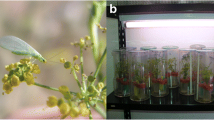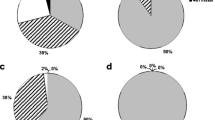Abstract
Growth, development and fecundity of Maruca vitrata Fabricius (Lepidoptera: Crambidae) were studied on artificial diet and flowers of two accessions each of three wild Vigna species, namely V. vexillata (TVnu 594 and TVnu 72), V. oblongifolia (TVnu 957 and TVnu 42) and V. unguiculata ssp. dekindtiana (TVnu 979 and TVnu 863) and six accessions of cowpea, V. unguiculata ssp. unguiculata (Moussa Local, VICAM-1, TVu 13731, IT84S-2246, IT89KD-457 and IT91K-180). The percentage survival of the larvae, larval weights as well as growth and development indices were significantly higher on the artificial diet, flowers of cowpea cultivars and those of V. unguiculata ssp. dekindtiana compared to those of V. vexillata and V. oblongifolia. The fecundity of females from larvae reared on artificial diet and flowers of cowpea was also significantly higher than that of females from the wild Vigna genotypes. All variables were included in principal component analysis. Two components accounted for 81.79%. On the basis of this analysis, the diets appeared to fall into four categories based on their suitability for supporting development of M. vitrata: unsuitable (TVnu 42 and TVnu 957), fairly suitable (TVnu 72, TVnu 594, TVnu 979, Moussa Local and TVnu 863), suitable (IT89KD-457, IT91K-180, VICAM-1, TVu 13731 and IT84S-2246), and very suitable (artificial diet). The importance of these findings in the development of host plant resistance of cowpea to M. vitrata is discussed.
Résumé
On a étudié la croissance, le développement et la fécondité de Maruca vitrata élevé sur un aliment artificiel et sur des fleurs de deux entrées chacune, provenant de trois espèces sauvages de Vigna notamment V. vexillata. (TVnu 594 et TVnu 72), V. oblongifolia (TVnu 957 et TVnu 42) et V. unguiculata (TVnu 979 et TVnu 863). La même étude a porté sur six entrées de niébé, V. unguiculata ssp. dekindtiana (Moussa local, VICAM-1, TVu 13731, IT84S-2246, IT89KD-457 et IT91K-180). Les taux de survie, le poids, la croissance et les indices de développement des larves étaient sensiblement plus élevés sur milieu artificiel, les fleurs des cultivars du niébé et celles de V. unguiculata ssp. dekindtiana en comparaison de V. vexillata et V. oblongifolia. La fécondité des femelles issues des larves nourries avec l’aliment artificiel et les fleurs du niébé était aussi sensiblement plus élevée que celle des femelles provenant des génotypes sauvages de Vigna. Toutes les variables ont été incluses dans l’analyse de la composition principale et deux composés ont compté pour 81,79%. Sur base de cette analyse, les régimes alimentaires ont semblé tomber dans quatre catégories selon leur aptitude de favoriser le développement de M. vitrata. On a noté qu’il y avait des régimes peu convenables (TVnu 42 et TVnu 957); des aliments assez appropriés (TVnu 72, TVnu 594, TVnu 979, Moussa local, et TVnu 863); des aliments appropriés (IT89KD-457, IT91K-180, VICAM-1, TVu 13731 et IT84S-2246), et d’autres très appropriés (aliment artificiel). L’article discute de la portée de ces résultats dans le développement de la résistance du niébé, une plante hôte de M. vitrata.
Similar content being viewed by others
References
Banerjee T. C. and Chatterjee M. (1985) Seasonal changes in feeding, fat body and ovarian conditions of Nezara viridula L. (Heteroptera: Pentatomidae). Insect Sci. Applic. 6, 633–635.
Beck S. D. (1972) Nutrition, adaptation and environment, pp. 1–6. In Insect and Mite Nutrition (Edited by J. G. Rodriguez). North Holland, Amsterdam.
Dyar H. G. (1890) The number of molts in lepidopterous larvae. Psyche 5, 240–422.
Fatokun C. A., Perrino P. and Ng N.Q. (1997) Wide crossing in African Vigna species, pp. 50–57. In Advances in Cowpea Research (Edited by B. B. Singh, D. R. Mohan Raj, K. E. Dashiell and L. E. N. Jackai). Copublication of International Institute of Tropical Agriculture (IITA) and Japan International Research Center for Agricultural Sciences (JIRCAS). IITA, Ibadan, Nigeria.
International Institute of Tropical Agriculture (IITA) (1993) Annual Report for 1992. 64 pp.
Jackai L. E. N. (1981) Relationship between cowpea crop phenology and field infestation by the legume pod borer, Maruca testulalis. Ann. Entomol. Soc. Am. 94, 402–408.
Jackai L. E. N. (1995) The legume pod borer Maruca testulalis and its principal host plant, Vigna unguiculata (L.) Walp: Use of selective insecticide sprays as an aid in the identification of useful levels of resistance. Crop Prot. 14, 299–306.
Jackai L. E. N. and Raulston J. R. (1988) Rearing the legume pod borer, Maruca testulalis Geyer (Lepidoptera: Pyralidae) on artificial diet. Trop. Pest Manage. 34, 168–172.
Jackai L. E. N. and Singh S. R. (1981) Studies on some behavioural aspects of Maruca testulalis on selected species of Crotalaria and Vigna unguiculata. Trop. Grain Legume Bull. No. 22, 3–6.
Jackai L. E. N. and Singh S. R. (1983) Varietal resistance in the integrated pest management of cowpea pests. Insect Sci. Applic. 4, 199–204.
Jackai L. E. N., Padulosi Sb M. and Ng Q. (1996) Resistance to the legume pod borer, Maruca vitrata Fabricius and the probable modalities involved in wild Vigna. Crop Prot. 15, 753–761.
Nijhout H. F. (1975) A threshold size for metamorphosis in the tobacco hornworm Manduca sexta (L.). Biol. Bull. 149, 214–225.
Nijhout H. F. and Williams C. M. (1974) The control of moulting and metamorphosis in Manduca sexta (Lepidoptera): Growth of the last instar larva and the decision to moult. J. Exp. Biol. 61, 481–491.
Oghiakhe S., Jackai L. E. N., Hodgson C. J. and Ng Q. N. (1993) Anatomical and biological parameters of resistance of the wild cowpea Vigna vexillata Benth (Acc. TVnu 72) to Maruca testulalis Geyer (Lepidoptera: Pyralidae). Insect Sci. Applic. 14, 315–323.
Oghiakhe S., Jackai L. E. N., Makanjuola W. A. and Hodson C. J. (1992) Morphology, distribution and the role of trichome in cowpea (Vigna unguiculata) resistance to the legume pod borer, Maruca testulalis (Lepidoptera: Pyralidae). Bull. Ent. Res. 82, 499–505.
Otieno D. A., Hassanali A. and Njoroge P. E. W. (1984) Chemical basis of TVu 946 cowpea resistance to Maruca testulalis (Geyer). 12th Annual Report, International Centre of Insect Physiology and Ecology.
Painter R. H. (1968) Crops that resist insects provide a way to increased world food supply. Kans. Agric. Exp. Stn. Bull. No. 520, 22 pp.
Singh S. R., Jackai L. E. N., Dos Santos J. H. R. and Adalla C. B. (1990) Insect pests of cowpea, pp. 43–89. In Insect Pests of Tropical Food Legumes (Edited by S. R. Singh). John Wiley & Sons, New York.
Soo Hoo C. F. and Fraenkel G. (1966) The consumption, digestion and utilization of food plants by a polyphagous insect, Prodenia eridania (Cramer). J. Insect Physiol. 12, 711–730.
Stipanovic R. D., Williams H. J. and Smith L. A. (1986) Cotton terpenoid inhibition of Heliothis virescens development, pp. 79–94. In Natural Resistance of Plants to Pests: Roles of Allelochemicals (Edited by M. B. Green and P. A. Hedin). ACS Symposium Series 296. American Chemical Society, Washington, D.C.
Taylor T. A. (1968) The effects of insecticide application on insect damage and the performance of cowpea in southern Nigeria. Niger. Agric. J. 5, 29–37.
Taylor T. A. (1978) Maruca testulalis. An important pest of tropical grain legumes, pp. 187–200. In Pests of Grain Legumes: Ecology and Control (Edited by S. R. Singh, T. A. Taylor and H. F. van Emden). Academic Press, London.
Waldbauer G. P. (1968) The consumption and utilization of food by insects. Adv. Insect Physiol. 5, 229–288.
Author information
Authors and Affiliations
Corresponding author
Rights and permissions
About this article
Cite this article
Oigiangbe, N.O., Jackai, L.E.N., Ewete, F.K. et al. The Nutritional Ecology of Maruca vitrata Fabricius I. Development on Flowers of Wild and Cultivated Vigna Species. Int J Trop Insect Sci 20, 259–268 (2000). https://doi.org/10.1017/S1742758400015617
Accepted:
Published:
Issue Date:
DOI: https://doi.org/10.1017/S1742758400015617




